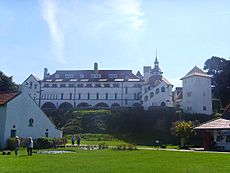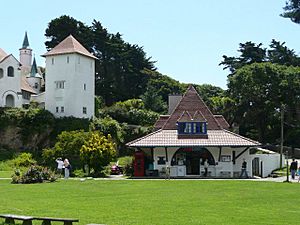Caldey Abbey facts for kids
Quick facts for kids Caldey Abbey |
|
|---|---|
 |
|
| Lua error in Module:Location_map at line 420: attempt to index field 'wikibase' (a nil value). | |
| Location | Caldey Island, Pembrokeshire |
| Country | Wales |
| Denomination | Roman Catholic Church |
| History | |
| Status | Abbey |
| Founded | 1910 |
| Architecture | |
| Functional status | Active |
| Heritage designation | Grade II* listed |
| Administration | |
| Deanery | Pontypridd |
Caldey Abbey is a special place where monks live and work. It's an abbey of the Trappists (a type of Roman Catholic monk). The abbey is located on Caldey Island, which is off the coast of Pembrokeshire, Wales. You can find it south of the town of Tenby.
Caldey Island has been a home for monks for a very long time. Monks have lived here since ancient Celtic times. The abbey you see today was built in 1910. It was first built by Anglican Benedictine monks. Later, in 1929, it became home to the Trappist monks.
As of 2018, about 10 monks live at Caldey Abbey. They are well-known for making lavender perfume, shortbread, and chocolate. They even opened an online shop in 2001 to sell their products.
Contents
History of Caldey Abbey
Early Monasteries on the Island
A Celtic monastery was first started on Caldey Island in the 500s. Later, around 1136, a Benedictine monastery was built. This monastery lasted until 1536, when many monasteries were closed down.
Pyro was the first abbot (leader) of the early monastery. Saint Samson was also one of the important early abbots.
Building the Current Abbey
In 1900, a man named William Done Bushell offered Caldey Island to Dom Aelred Carlyle. Carlyle was a leader of an Anglican Benedictine group. His community arrived on the island in 1906.
They built the current abbey between 1906 and 1910. It was designed in the Italian style. At first, they built small houses for the workers. Because of this, the abbey was sometimes called the "cottage Monastery." The chapel was finished in 1910.
Changes in Monks
In 1913, the monks at Caldey Abbey became part of the Roman Catholic Church. A small group of Anglican monks left the island. They moved to another abbey.
The Catholic Benedictine monks stayed until 1928. Then, in 1929, a different group of monks arrived. These were the Trappists, who are known for their very strict way of life. They came from Scourmont Abbey in Belgium. The monastery had to be rebuilt in 1940 after a fire.
Life at the Monastery
The monks at Caldey Abbey live a simple life. They also work to support themselves and the abbey. They make several products that help them earn money.
Their main sources of income are:
- Making perfume
- Baking shortbread
- Producing chocolate
They also sell prime beef from their farm. In 2001, the monastery opened an internet shop. This allows people from all over to buy their products. Their chocolate is also sold under the name "Abbot's Kitchen."
Caldey Abbey Lavender Perfume
Caldey Island has many wild lavender flowers. This inspired the monks to create their own perfumes. They named their scents "Caldey Abbey Perfumes."
The perfumes became very popular. Because of high demand, they now need to bring in scent oil from outside the island. The perfume is made all year round. It even includes scents from the island's gorse plants.
Abbey Buildings and Design
The abbey buildings are a great example of the Arts and Crafts movement style. This was a popular design style in the late 1800s and early 1900s. The architect, John Coates Carter, designed this as his biggest project.
The roofs of the buildings are white with red tiles. The large arches in the basement are made of brick. The abbey church has a tall south tower. This tower has five windows and a unique, tapering shape. The windows are simple, with lead glass.
When first built, the abbey had fancy silver and ebony decorations. Sadly, many of these were destroyed in the 1940 fire. The dining hall, called the refectory, was made from beautiful wood. It had a modern design inspired by older patterns.
To make sure there's always enough water, the abbey has two large underground water tanks. A narrow water shaft helps collect water, preventing water scarcity during dry times.
Caldey Abbey is a very important building. It is listed as a Grade II* listed building. This means it is a building of special historical or architectural interest. The Abbey Shop and other buildings on the island are also listed.


